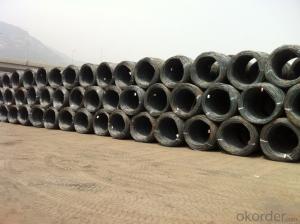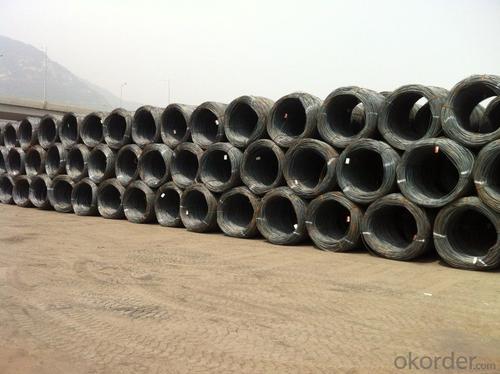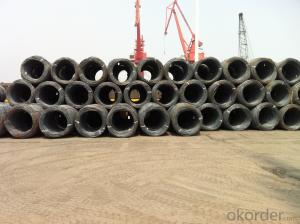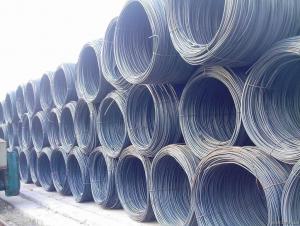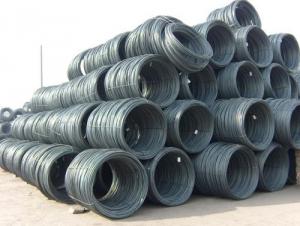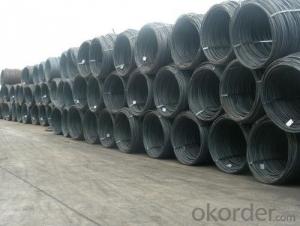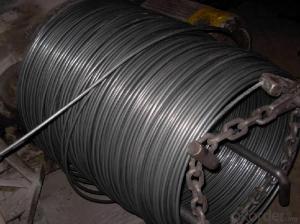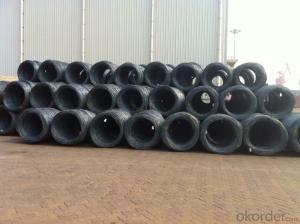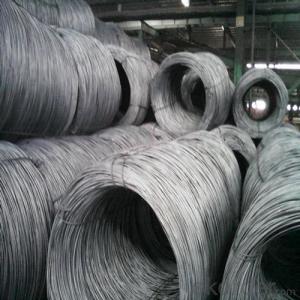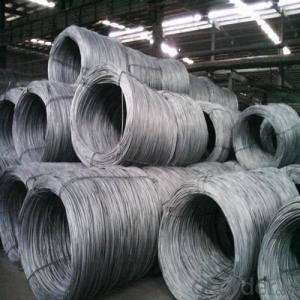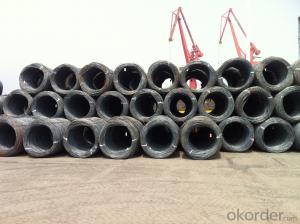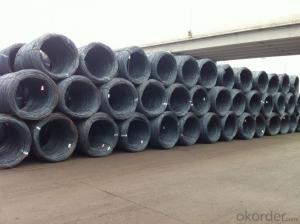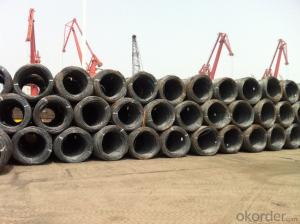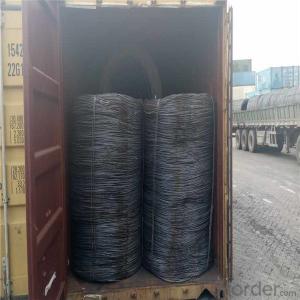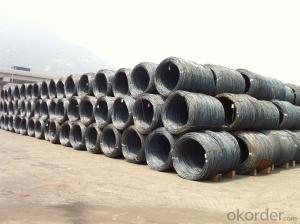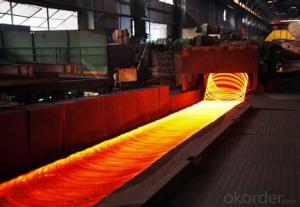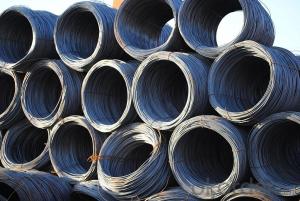SAE1008 Wire Rods with Competitive Price
- Loading Port:
- Tianjin
- Payment Terms:
- TT OR LC
- Min Order Qty:
- 25 m.t.
- Supply Capability:
- 20000 m.t./month
OKorder Service Pledge
OKorder Financial Service
You Might Also Like
Product Description:
OKorder is offering SAE1008 Wire Rods at great prices with worldwide shipping. Our supplier is a world-class manufacturer of steel, with our products utilized the world over. OKorder annually supplies products to European, North American and Asian markets. We provide quotations within 24 hours of receiving an inquiry and guarantee competitive prices.
Product Applications:
SAE1008 Wire Rods are ideal for structural applications and are widely used in the construction of buildings and the manufacturing, industries.
Product Advantages:
OKorder's Wire Rods are durable, strong, and resist corrosion.
Main Product Features:
· Premium quality
· Prompt delivery & seaworthy packing (30 days after receiving deposit)
· Corrosion resistance
· Can be recycled and reused
· Mill test certification
· Professional Service
· Competitive pricing
Product Specifications:
Manufacture: Hot rolled
Grade: SAE1006 – SAE1008
Certificates: ISO, SGS, BV, CIQ
Length: 6m – 12m, as per customer request
Packaging: Export packing, nude packing, bundled
Grade | Chemical Composition (%) | |||||
C | Mn | S | P | Si | B | |
SAE1006B | 0.03~O.07 | 0.32max | 0.045max | 0.040max | 0.30max | 0.0008min |
Mechanical properties | ||||||
Yield strength(N/mm2) | Tensile strength(N/mm2) | Elongation (%) | ||||
250-280 | 350-380 | ≥32 | ||||
Grade | Chemical Composition (%) | |||||
C | Mn | S | P | Si | B | |
SAE1008B | 0.10max | 0.3~0.50 | 0.050max | 0.040 max | 0.15max | 0.0008 min |
Mechanical properties | ||||||
Yield strength(N/mm2) | Tensile strength(N/mm2) | Elongation (%) | ||||
≥195 | 315-430 | ≥30 | ||||
FAQ:
Q1: Why buy Materials & Equipment from OKorder.com?
A1: All products offered byOKorder.com are carefully selected from China's most reliable manufacturing enterprises. Through its ISO certifications, OKorder.com adheres to the highest standards and a commitment to supply chain safety and customer satisfaction.
Q2: How do we guarantee the quality of our products?
A2: We have established an advanced quality management system which conducts strict quality tests at every step, from raw materials to the final product. At the same time, we provide extensive follow-up service assurances as required.
Q3: What makes stainless steel stainless?
A3: Stainless steel must contain at least 10.5 % chromium. It is this element that reacts with the oxygen in the air to form a complex chrome-oxide surface layer that is invisible but strong enough to prevent further oxygen from "staining" (rusting) the surface. Higher levels of chromium and the addition of other alloying elements such as nickel and molybdenum enhance this surface layer and improve the corrosion resistance of the stainless material.
Images:
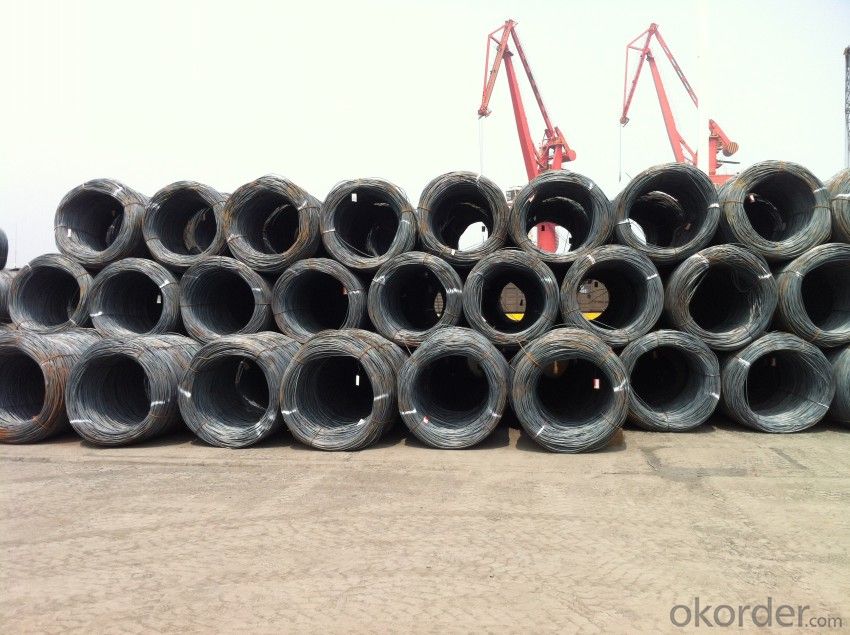
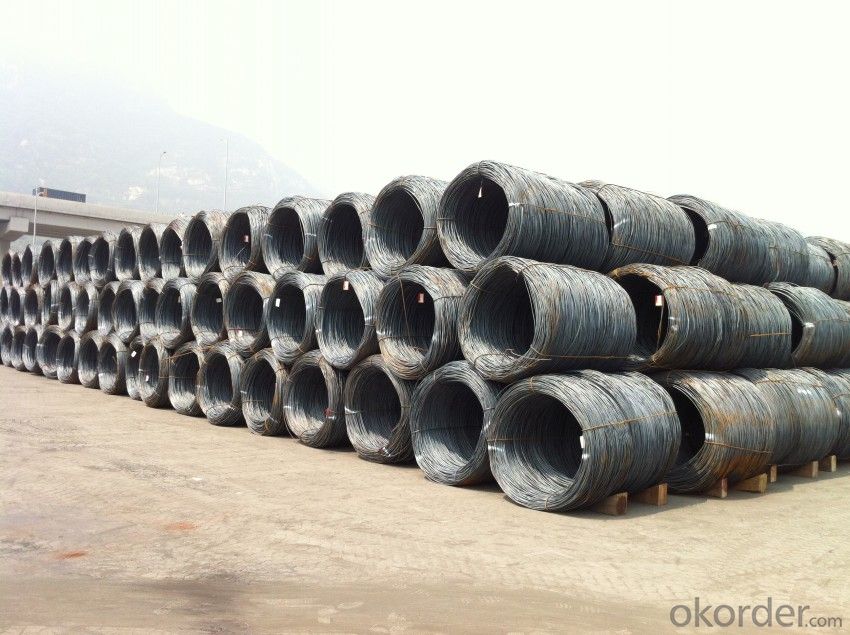
- Q: What are the safety requirements for steel wire rod used in ski lift wire ropes?
- The safety requirements for steel wire rod used in ski lift wire ropes are crucial to ensure the safe and reliable operation of ski lifts. These requirements are designed to minimize the risk of accidents and maintain the structural integrity of the wire ropes. Firstly, the steel wire rod used in ski lift wire ropes must meet specific material standards. It should be made from high-quality, high-strength steel that is capable of withstanding the tension and stress encountered during ski lift operations. The wire rod should adhere to international standards such as ASTM A1023/A1023M or EN 12385, which specify the minimum mechanical properties and chemical composition of the wire rod. In addition to material requirements, the wire rod must undergo rigorous testing and inspection processes. This includes non-destructive testing techniques like ultrasonic examination, magnetic particle inspection, and visual inspection to identify any defects or imperfections in the wire rod. The testing should be performed by certified and qualified personnel to ensure accuracy and reliability. Furthermore, the wire rod used in ski lift wire ropes must have a specific diameter and tolerance range to maintain the desired strength and performance. Ski lift manufacturers typically provide specifications that dictate the required diameter and tolerance for the wire rod to be used in their systems. These specifications should be followed closely to ensure compatibility and safety. It is also essential to consider the surface requirements of the wire rod. The wire rod should have a smooth and clean surface, free from any burrs, cracks, or other surface defects that could compromise the structural integrity of the ski lift wire ropes. Any surface irregularities should be addressed through appropriate surface treatments or inspections. Lastly, regular maintenance and inspection of the ski lift wire ropes are necessary to ensure ongoing safety. This includes visual inspections, lubrication, and tension checks to detect any signs of wear, corrosion, or fatigue. If any issues are identified, immediate action should be taken to repair or replace the affected wire ropes to prevent accidents or failures. Overall, the safety requirements for steel wire rod used in ski lift wire ropes encompass material standards, testing, dimensional specifications, surface quality, and ongoing maintenance. Adhering to these requirements ensures the reliability and safety of ski lifts, providing a secure and enjoyable experience for skiers.
- Q: How is steel wire rod used in the production of wire mesh for filtration?
- Steel wire rod is an essential component in the production of wire mesh for filtration. It serves as the raw material for manufacturing wire mesh, which is widely used in various industries such as mining, construction, and agriculture. To produce wire mesh for filtration, the steel wire rod goes through a series of manufacturing processes. First, the wire rod is heated and then rolled into thin strands, known as wire. These wires are typically of a consistent diameter and have a smooth surface to ensure high-quality filtration. Next, the wire is woven or welded to create the desired mesh pattern. The weaving process involves interlacing the wires over and under each other, forming a stable and durable mesh structure. Alternatively, the wires can be welded at their intersections to create a more rigid mesh. The steel wire rod used in the production of wire mesh for filtration is chosen for its specific properties. Steel is known for its strength, durability, and corrosion resistance, making it suitable for demanding filtration applications. Additionally, the wire rod can be further treated to enhance its performance, such as by applying coatings to improve resistance to abrasion or chemicals. Once the wire mesh is manufactured, it is used in various filtration applications. Wire mesh filters are commonly used to separate solids from liquids or gases, removing impurities and contaminants. They are also utilized as sieves or screens to classify or separate materials based on their size or shape. In summary, steel wire rod is a crucial material in the production of wire mesh for filtration. It undergoes several manufacturing processes to create the wire mesh, which is then used in diverse filtration applications across different industries. The strength, durability, and corrosion resistance of steel make it an ideal choice for demanding filtration requirements.
- Q: How is steel wire rod used in the manufacturing of wire shelving units?
- Steel wire rod is used in the manufacturing of wire shelving units as it serves as the primary material for creating the frame and structure of the shelves. The steel wire rod is shaped and formed into various configurations to create the shelving unit's vertical posts, horizontal shelves, and support brackets. This strong and durable material ensures the stability and strength of the shelving unit, making it capable of holding and organizing heavy items securely.
- Q: What are the different surface defects that can impact the electrical resistance of steel wire rod?
- Some of the different surface defects that can impact the electrical resistance of steel wire rod include surface scale, pits, scratches, and surface contaminants. These defects can create localized areas of increased resistance, leading to variations in electrical conductivity along the wire rod.
- Q: What are the standard fatigue resistance requirements for steel wire rod?
- The fatigue resistance requirements for steel wire rods vary depending on the specific application and industry standards. However, there are some general guidelines that can be taken into consideration. Industries such as automotive, aerospace, and construction place great importance on fatigue resistance when it comes to steel wire rods. These rods experience cyclic loading and stress, which can result in fatigue failure if the material is not designed to withstand these conditions. Fatigue tests, such as rotating bending or axial fatigue tests, are typically used to determine the fatigue resistance requirements for steel wire rods. These tests subject the wire rod to repeated cycles of loading and unloading under specific conditions, such as stress amplitude and frequency. Parameters such as fatigue strength, fatigue life, and fatigue limit are often used to quantify the fatigue resistance of steel wire rods. Fatigue strength represents the maximum stress level that the wire rod can endure for a specified number of cycles without failure. Fatigue life indicates the number of cycles that the wire rod can sustain before failure occurs. The fatigue limit, also known as endurance limit, is the stress level below which the wire rod can theoretically endure an infinite number of cycles without failure. The specific fatigue resistance requirements for steel wire rods can vary based on factors such as the intended use, material composition, and expected service life. These requirements are typically defined by industry standards and specifications, such as those established by organizations like ASTM or ISO. Manufacturers and engineers must carefully consider the fatigue resistance requirements for steel wire rods to ensure the safety and reliability of the final products. This involves selecting the appropriate material grade, conducting thorough testing and analysis, and adhering to industry standards and specifications.
- Q: How is the steel wire rod industry affected by fluctuations in raw material prices?
- The steel wire rod industry experiences significant effects due to fluctuations in raw material prices. Raw materials, including iron ore, coal, and scrap metal, play a crucial role in the production of steel wire rods. Any changes in the prices of these raw materials can directly influence the production costs for manufacturers of steel wire rods. When there is an increase in raw material prices, it directly raises the input costs for producing steel wire rods. This situation puts pressure on manufacturers to either absorb the higher costs, leading to reduced profit margins, or pass on the increased costs to customers in the form of higher prices. In either scenario, the competitiveness of steel wire rod manufacturers in the market can be impacted. On the contrary, when there is a decrease in raw material prices, it can provide some relief to steel wire rod manufacturers as it reduces their production costs. This enables manufacturers to offer lower prices or maintain their profit margins while remaining competitive in the market. Fluctuations in raw material prices also have an impact on the supply chain of the steel wire rod industry. Manufacturers depend on a steady supply of raw materials, and any disruptions or price volatility can affect their ability to procure sufficient quantities of raw materials. This can result in production delays, higher inventory costs, and overall productivity issues in the industry. Furthermore, fluctuations in raw material prices can also influence the profitability of steel wire rod manufacturers. If raw material prices increase significantly and manufacturers are unable to pass on the increased costs to customers, it can lead to reduced profitability and potentially financial losses. Conversely, when raw material prices decrease, manufacturers may experience improved profitability. In conclusion, fluctuations in raw material prices directly impact various aspects of the steel wire rod industry, including production costs, competitiveness, supply chain, and profitability. Consequently, industry players closely monitor and analyze trends in raw material prices to make informed decisions and mitigate the impacts of price fluctuations.
- Q: How is steel wire rod used in the production of wire grids?
- Steel wire rod is used in the production of wire grids by being drawn and stretched to the desired thickness and shape. This wire rod serves as the raw material that is woven or welded together to form the wire grids, which are commonly used in various applications such as fencing, shelving, and industrial racks.
- Q: How is steel wire rod used in the manufacturing of wire ties for construction sites?
- Steel wire rod is a vital component in the production of wire ties used on construction sites. These wire ties are extensively utilized in the construction industry for multiple purposes, such as securing rebar, reinforcing concrete structures, and fastening construction materials together. The steel wire rod acts as the primary material for manufacturing wire ties. It goes through a series of processes to transform it into the final product. Initially, the wire rod undergoes cleaning and coating to enhance its resistance to corrosion. This coating, commonly composed of zinc, provides an additional layer of protection against rust, ensuring the longevity of the wire ties in harsh construction environments. Following that, the coated steel wire rod is fed into a wire drawing machine, where it is pulled through a die to reduce its diameter to the desired size. This process is repeated multiple times to achieve the required thickness and strength of the wire. Once the wire is drawn to the desired gauge, it is then cut into appropriate lengths to produce individual wire ties. These lengths may vary depending on the specific application and requirements of the construction project. Using specialized machinery, the wire is then bent, twisted, or formed into the shape of a tie. Wire ties made from steel wire rod offer exceptional strength, durability, and flexibility. They can be easily bent or twisted to fit around various construction materials, ensuring a secure and tight connection. Furthermore, the high tensile strength of steel wire rod guarantees that the wire ties can withstand significant stress and load without breaking or deforming. Wire ties manufactured from steel wire rod are commonly employed on construction sites to secure and fasten rebar during concrete pouring. They are also utilized to reinforce concrete structures, such as walls, columns, and beams. Additionally, wire ties are used to bundle or tie together construction materials, including pipes, cables, and electrical wires, ensuring proper organization and minimizing potential hazards. In conclusion, steel wire rod plays a critical role in the production of wire ties for construction sites. These wire ties provide essential support and reinforcement in various construction applications, offering durability, flexibility, and strength to ensure the safety and stability of construction projects.
- Q: How is the quality of steel wire rod determined?
- The quality of steel wire rod is determined through various factors such as chemical composition, mechanical properties, surface condition, and dimensional accuracy. It undergoes testing and evaluation for its strength, ductility, and toughness using methods like tensile testing and hardness testing. Additionally, the surface condition is assessed for any defects, such as cracks or scale, while dimensional accuracy ensures the wire rod meets the required specifications.
- Q: How is the surface finish of steel wire rod evaluated?
- The surface finish of steel wire rod is typically evaluated through visual inspection, which involves examining the wire rod for any defects, imperfections, or irregularities on its surface. Additionally, it may also be evaluated through various testing methods such as magnetic particle inspection, ultrasonic testing, or microscopic analysis to ensure that the surface meets the desired specifications and standards.
Send your message to us
SAE1008 Wire Rods with Competitive Price
- Loading Port:
- Tianjin
- Payment Terms:
- TT OR LC
- Min Order Qty:
- 25 m.t.
- Supply Capability:
- 20000 m.t./month
OKorder Service Pledge
OKorder Financial Service
Similar products
Hot products
Hot Searches
Related keywords
